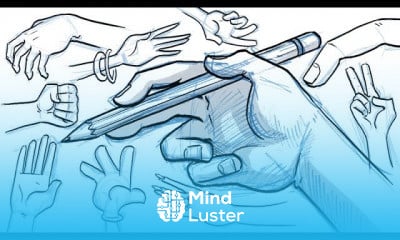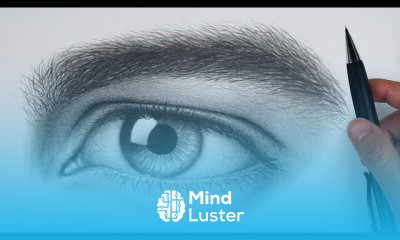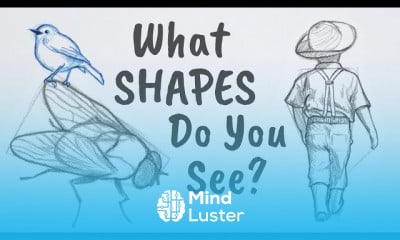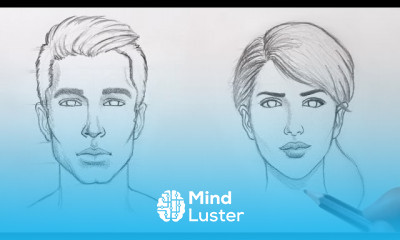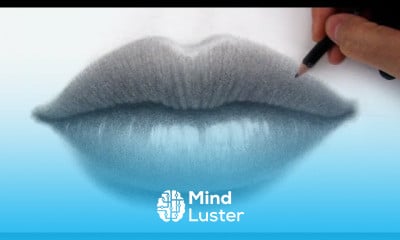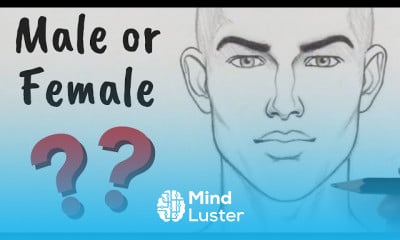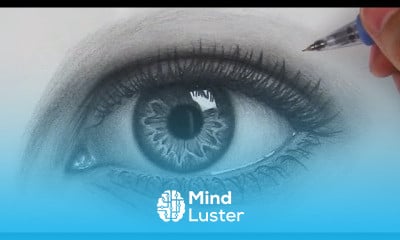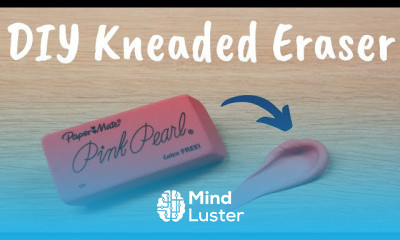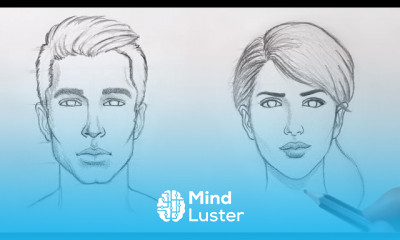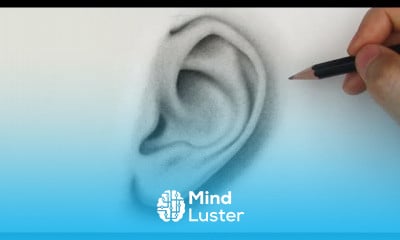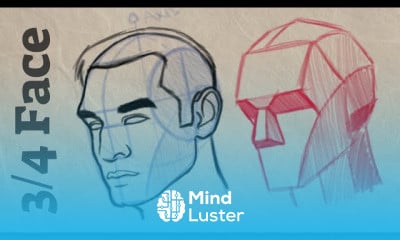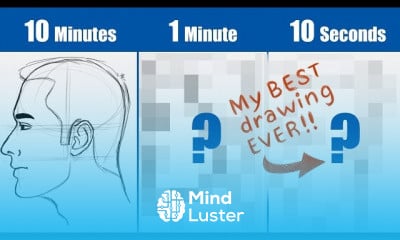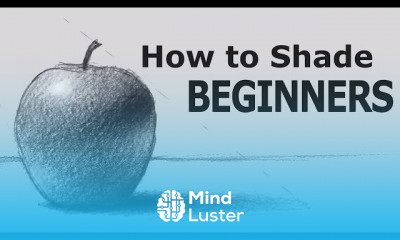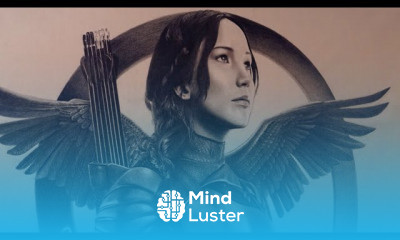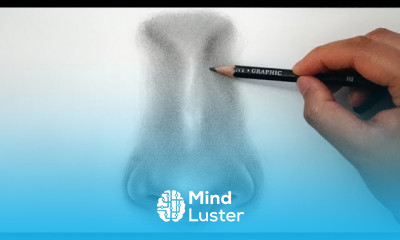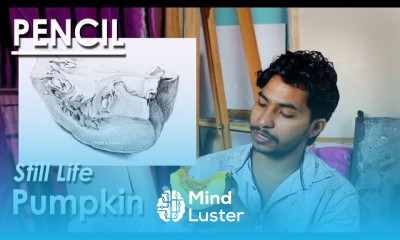How to Draw Male Female FACIAL Features
Share your inquiries now with community members
Click Here
Sign up Now
Lessons List | 2
Lesson
Comments
Related Courses in Drawing
Course Description
Step 1: Body Base: Height and Shoulder Width
Before we begin drawing out the body types, we will start by creating a base that we'll flesh out with the body types in the following steps.
Start by drawing a head, a simple oval with slight indents around the jaw area to define it a bit more. The great thing in illustrator is that you can add anchor points, so if you add two that are roughly at the top edge of the jawline, you'll only need to push them slightly inwards to define the jaw indent.
Now duplicate this head eight times and then place them in a straight line underneath the original head shape you drew. Lookit! You just figured out the height of your character with that. Generally the size of the human head can fit eight times (head excluded) in the human body, sometimes seven is the better number, but feet are excluded in that case. The last one (where the feet would be) is the more annoying one. Say the character is jumping and has her/his feet point downwards, you'd use the entire head to define the length, but, if she/he's standing, feet flat on the ground, cut the head in half to define the height.
To give you more than a straight line to work with, duplicate the second head at the top (neck area) twice and place them on either side of the second head. This will define the shoulder width, but to make it a bit easier as to figure out where they should start, lower the two duplicates down so that the top edge of them aligns with the middle of that second head (draw a line to cut it in two if needed). This didn't just help define the height and width of the shoulders, but the head shapes we're using has just created the shoulder curve that connects the arms for you.
To finish it off, we're going to shape out a triangle to define the ribcage. Using the shoulder width line we just created, draw two diagonal lines connecting back with one another by the middle of the fifth head. We've got a great reference for the ribcage.
Step 2: Body Base: Arms, Legs and Hands
Using the diagonal lines of the ribcage triangle, you can figure out an approximate arm length with it. So, draw a line over one of either diagonal ribcage lines and then tweak them so they bow outwards and connect the top point with the shoulder curve, repeat that on the other side and once that complete, you now have the arm lengths (hands aren't included).
Fancy part is, you use that exact line to define the thighs. So, duplicate the arm line again and attach your thighs. To judge where they should start, cut the fourth head in half and use the center line to attach the top points of the thigh lines to it. Duplicate those lines and attach them to the bottom points of the thigh lines. Since they bow outwards, they won't be very useful as lower leg references, we'd need straighter lines. But, the bowed lines will help us judge how long the straight line should be, so draw a straight line from the top point to bottom that is the same length as the bowed lines and then delete the bowed ones!
Tips on hands and feet: A hand is roughly the same length as your face and that is almost applicable on the feet as well. A hand is generally the same size as your foot without the toes. So if you draw a straight line through one of the heads that is the same height and then attach them to the arm lines, you'll have a good base for the hands. Since the feet are presented flat on the ground in this base, they were included in the lower leg lines. With that done, we can start shaping out body types!
Step 3: Slim Figure Female
I'll be ignoring the legs and arms, focusing on the upper body only since those sort of speak for themselves. Since this body type essentially has the least flesh, we want to use sharp edged shapes to help define it as the bones show more prominently. We'll use two thin horizontally placed rectangles to help us draw the hips and ribcage/chest area and then a wider and longer rectangle set vertically between the two horizontal ones (see screenshot). Once you've drawn this out, we're going to fit it into our body base. You want the lower edge of the bottom rectangle to touch the crotch line, and the top edge of the top rectangle to cut through the middle of the shoulder area. Now you have an approximate height for the breasts and hip width and the rectangle in the middle will serve as reference to shape out the stomach.
You can duplicate the body base with the rectangles into a layer and then lower the opacity on it so you can draw out a rough of the body on top of it. This would be a rough that will then help you when you draw on top of it again to create your final version of the body type.
There are several things that can help when drawing on top of the rectangles and body base. You want to make the hips pointy/sharp edged and the line that connects hip to thigh should curve inwards before bowing out with the thigh, this will help define the sharp edged hips a little better. In the slim body type the ribcage usually is very present as well, if you want to take it further, you can go as far as drawing three small lines right below the breasts to have the bones showing through the flesh. Much like the hips, the shoulders would be sharp edged, same goes for elbows and knees. Otherwise, it's rare to see a slim person with voluptuous breasts, so following that, you want to make sure the outer line of the breasts is within the chest outline.
Step 4: Athletic Figure Female
This body type in the female series is one of those rare ones where we re-use the triangular shape created in the base to define the ribcage. When you look at athletic women, you'll notice that their hips are very narrow compared to the shoulder width, this is due to muscles building up and showing more prominently in the shoulders and arms. Basically, that curve you usually will find starts around the waist and hip area, starts higher in this case. It starts right below the ribcage and instead of curving inwards to define the waist, the line is straighter. So while usually it's a good plan to draw rounded/curved/smooth lines on a female figure, with the athletic body type we want to use sharper edges (as we did with the slim figure) but also straight lines.
Step 5: Toned Figure Female
For this figure we're going to use irregular quadrilaterals (see screenshot). Start by drawing the top one, making the bottom edge line shorter than the top and then duplicate it, mirror it vertically and place the duplicate underneath the first. Selecting both of these, we'll place them on top of the skeleton, making sure the top line of the top irregular quadrilateral aligns with the shoulders. Now we want to draw the body on top of this, following the shape these two shapes give us. Some things to keep in mind while doing this is that in the toned body type, the shoulder width is usually the same as the hips and while the waist is of course less wide, there shouldn't be a flagrant indent. Unlike the previous two body types, the outer line of the breasts touches the ribcage/chest outline rather than being drawn within. And what also makes it different is that here we don't want to draw any sharp edges or very straight lines, as usually toned figures have smooth muscles.
Before you duplicate your reference and draw the clean version on top of it, there's another thing we can do to define this body type more clearly. Allow the waist to be longer than the other body types, so select the entire figure and then stretch it upwards (this should work perfectly since you shouldn't stretch it so much that it'll disproportion the body). Otherwise you can also detach the upper body lines from the lower body and then add more length manually in the waist itself by drawing longer lines.
Trends
Data Science and Data Preparation
Artificial intelligence essentials
French
Programming for Data Science with R
Graphic design tools for beginners
Learning English Speaking
MS Excel
Formation efficace à l écoute de l
Electrical engineering for engineer
Build a profitable trading
American english speaking practice
Certified in CyberSecurity
Python for beginners
Build a tic tac Toe app in Xcode
Marketing basics for beginners
Web Design for Beginners
Essential english phrasal verbs
Figma for UX UI design
Data Mining for Data Science
WordPress Complete Course in Hindi
Recent
Qur anic reflections
Pillars of faith in islam
Pray in arabic word by word
Improve your Quran recitation
Read the Qur an
Islam in arabic basics
Qur an recitation
Arabic islamic words
Islamic vocabulary
Data Science and Data Preparation
Growing ginger at home
Gardening basics
Ancient watering techniques
Grow mushrooms
Growing onions
Veggie growing
Bean growing at home
Growing radishes
Tomato growing at home
Shallot growing



